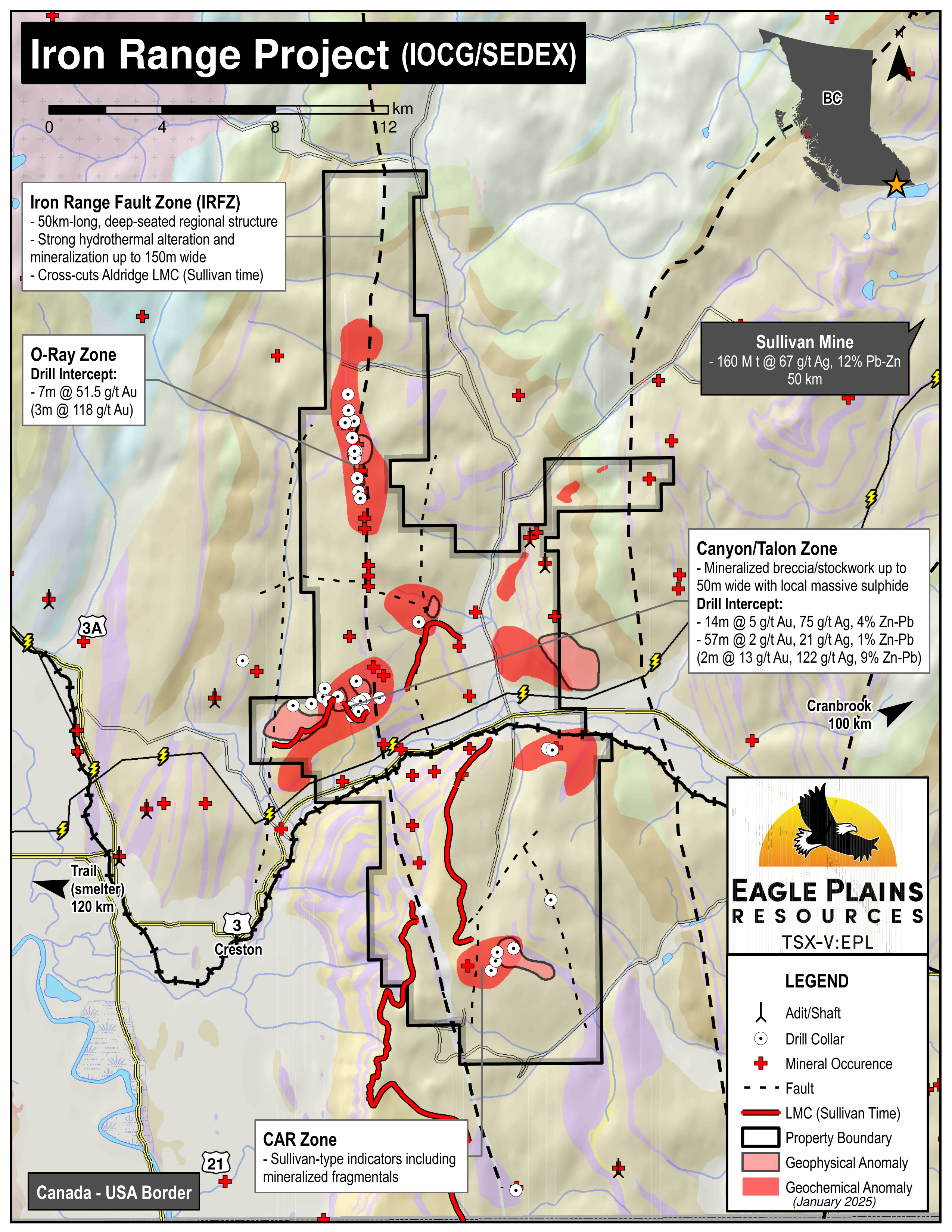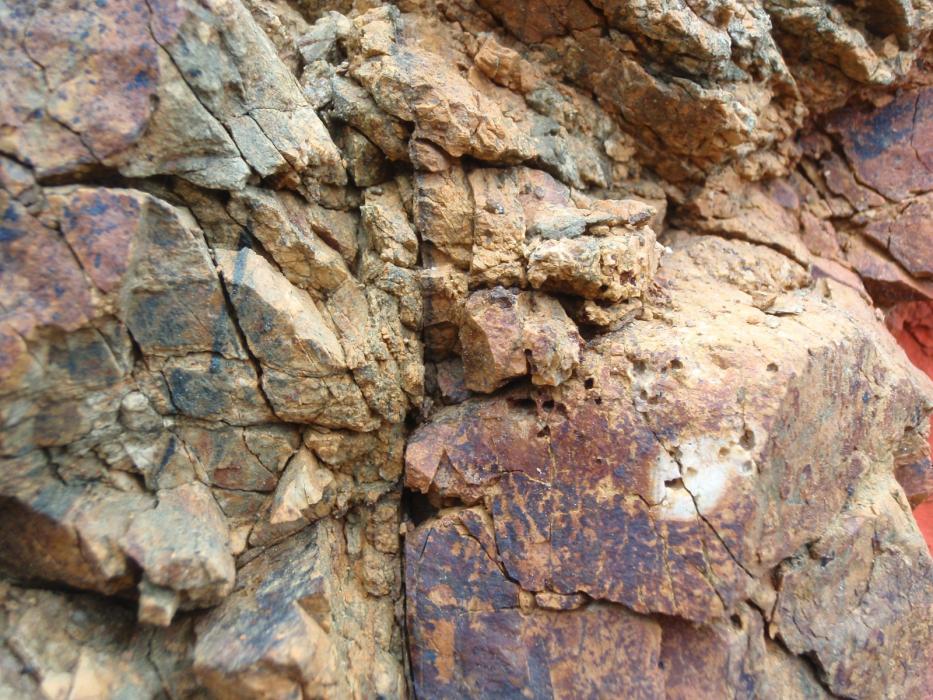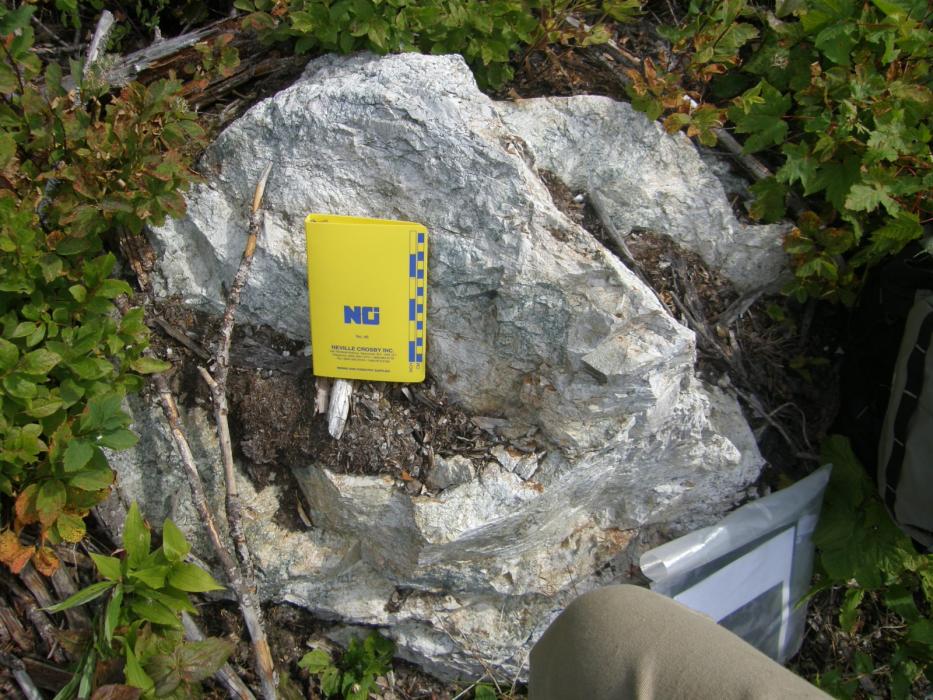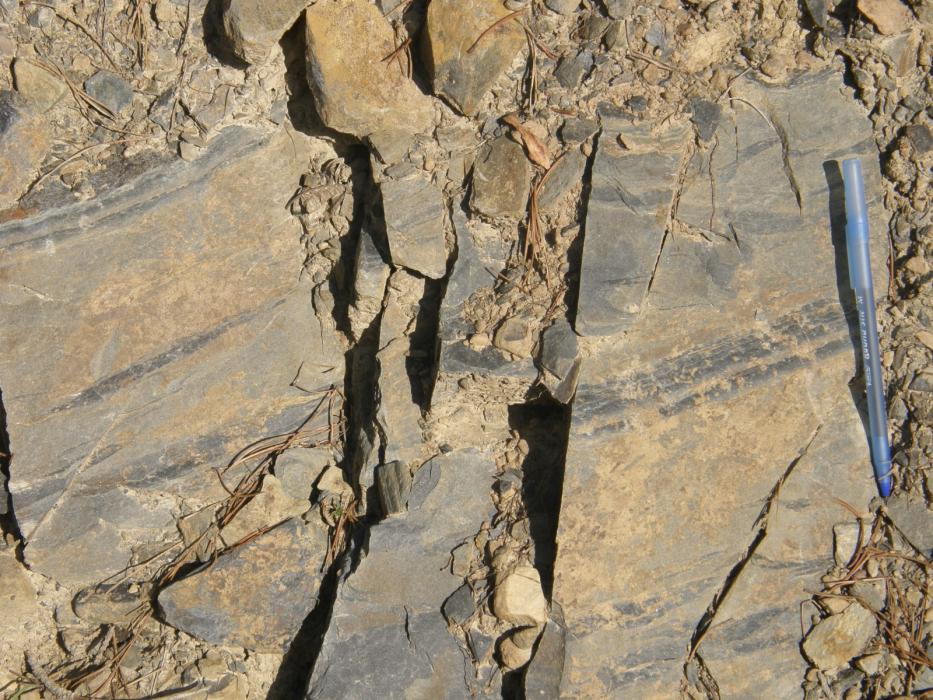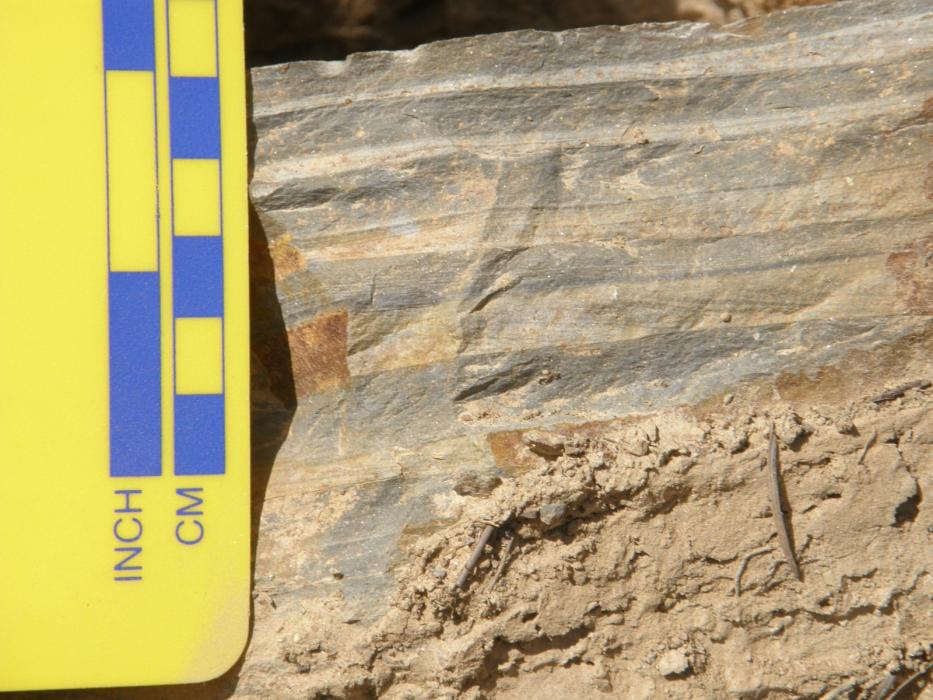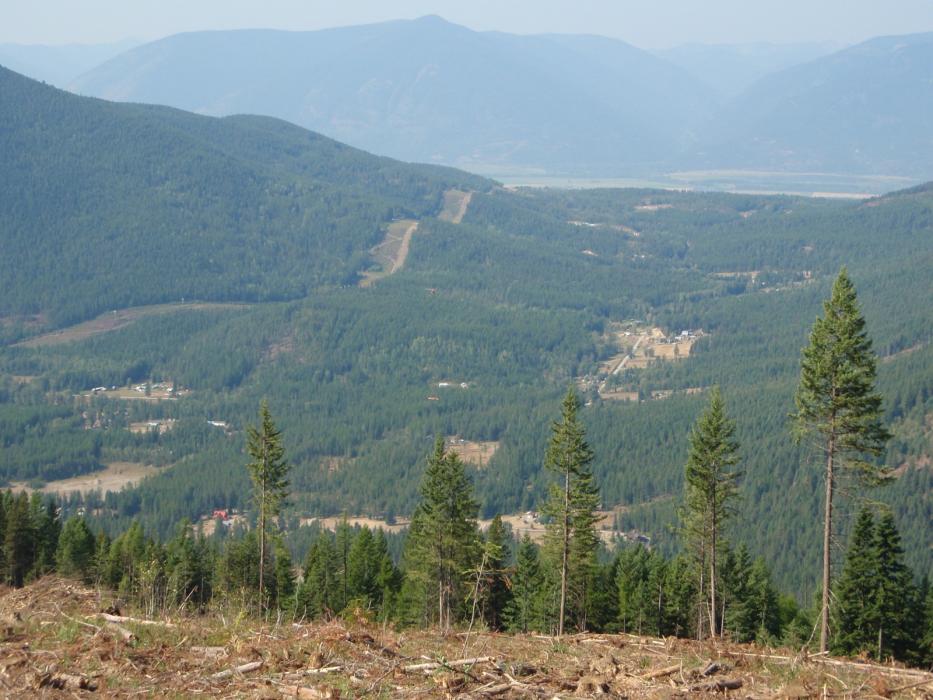
Iron Range Project
The 21,437 ha Iron Range Property is located 1 km NE of Creston in SE B.C. It overlies the same stratigraphy that hosts the world-class Sullivan sedimentary-exhalative (“SEDEX”) deposit in Kimberley, 65 km NE. The Sullivan contained 160M tons at 12% Pb/Zn and 67 g/t Ag valued today at over $35B, and had a mineable lifetime of 92 years before closing in 2001.
The Iron Range covers the Iron Mountain Fault Zone (IMFZ), a deep-seated regional fault containing significant iron oxide and iron sulphide mineralization. Originally staked in 1897 for its iron potential, Eagle Plans immediately staked it when the overlying Crown Grants expired in 1999. Eagle Plains has focused on exploring for both SEDEX Ag-Pb-Zn and iron-oxide-copper-gold (“IOCG”) mineralization.
The Iron Range is accessed by Hwy 3 and a network of logging roads and is very well-situated with respect to infrastructure.
-
- British Columbia
-
- Available for option: No
-
- Gold,
- Zinc,
- Silver,
- Copper,
- Iron,
- Lead
Project Highlights
- Large property package overlying world-class SEDEX stratigraphy with IOCG potential
- Widespread Sullivan-type (SEDEX) indicators
- High-grade gold intercepts associated with regional-scale Iron Mountain structure
- Multiple targets associated with untested coincident geochemical/geophysical anomalies within prospective stratigraphy
- Excellent infrastructure: road-accessible bisected by rail, highway, gas, hydro with nearby smelter
Summary
The 21,437 ha Iron Range Property is located 1 km NE of Creston in SE B.C. It overlies the same stratigraphy that hosts the world-class Sullivan sedimentary-exhalative (“SEDEX”) deposit in Kimberley, 65 km NE. The Sullivan contained 160M tons at 12% Pb/Zn and 67 g/t Ag valued today at over $35B, and had a mineable lifetime of 92 years before closing in 2001.
The Iron Range covers the Iron Mountain Fault Zone (IMFZ), a deep-seated regional fault containing significant iron oxide and iron sulphide mineralization. Originally staked in 1897 for its iron potential, Eagle Plans immediately staked it when the overlying Crown Grants expired in 1999. Eagle Plains has focused on exploring for both SEDEX Ag-Pb-Zn and iron-oxide-copper-gold (“IOCG”) mineralization.
The Iron Range is accessed by Hwy 3 and a network of logging roads and is very well-situated with respect to infrastructure.
Project Highlights
- Large property package overlying world-class SEDEX stratigraphy with IOCG potential
- Widespread Sullivan-type (SEDEX) indicators
- High-grade gold intercepts associated with regional-scale Iron Mountain structure
- Multiple targets associated with untested coincident geochemical/geophysical anomalies within prospective stratigraphy
- Excellent infrastructure: road-accessible bisected by rail, highway, gas, hydro with nearby smelter
Geology
The Iron Range Property contains over 50 km strike-length of the 90 km long IMFZ: a N-S striking fault corridor with an E-W extent of up to 3 km. The central core of the IMFZ outcrops as hydrothermal breccia up to 150 m wide containing iron oxide and iron sulphide mineralization. The IMFZ also cross-cuts the Proterozoic Lower – Middle Aldridge Formation (“LMC”), which is the stratigraphic host for the world-class Sullivan deposit.
SEDEX
The combination of well-developed "Sullivan smoke" including tourmaline alteration, albite alteration, sedimentary fragmental units, disseminated sulphides and an extensive multi-element soil geochemical anomaly coincident with the LMC or “Sullivan time”, and the presence of a major deep-seated regional scale structure indicates the possibility of a nearby vent system similar to the one that formed the Sullivan deposit.
IOCG
Felsic intrusions in proximity to or in contact with major iron oxide bearing fault zones are known to be prospective for significant copper-precious metal deposits. The IMFZ is in close proximity to large felsic-intermediate intrusions which flank the western margin of the north and central portions of the property. Recent work by MDRU has indicated the potential for precious metal enriched iron oxide type mineralization on the property.
Epithermal
Fault splays associated with the IMFZ contain metals and alteration minerals indicative of epithermal style mineralization. Base metals (sphalerite and galena) and precious metals (gold and silver) have been deposited within brittle shear zones as disseminated to massive sulphide/sulphosalts hosted within silica-k-feldspar-sericite-carbonate altered and brecciated metasedimentary rocks of the Aldridge Formation.
History
The original Iron Range prospect was discovered and staked by CM&S (later Cominco) in 1897 for its iron resource potential. In 1957 an extensive trenching program exposing the Iron Mountain Fault structure and mineralization over more than 4 km strike-length. When the Iron Range Crown Grants reverted in 1999, Eagle Plains immediately staked the claims.
Iron Range Zones
The Iron Range Project is prospective for SEDEX, IOCG, and epithermal-style mineralization.
Talon/Canyon Zone
The Talon/Canyon Zone has been the focus of the majority of exploration efforts where drilling has intersected Ag-Au-Pb-Zn sulphide/sulphosalt mineralization typical of an intermediate sulphidation epithermal system. Mineralization is hosted in a steeply west dipping shear zone located approximately 400 m west of the IMFZ.
Sample Type Results Description of mineralization Drill 14m* @ 5.1 g/t Au, 1.86% Pb, 2.1% Zn, 75.3 g/t Ag massive sulphide Drill 56.5m* @ 1.9 g/t Au, 0.44% Pb, 0.59% Zn, 21.5 g/t Ag disseminated to net-textured mineralization Drill 2m* @ 12.8 g/t Au, 4.18% Pb, 5.06% Zn, 122.5 g/t Ag massive-sulphides then truncated by a fault
*the intersections are not representative of true thickness
Golden Cap/O-Ray Zone
At the Golden Cap/O-Ray Zone drilling intersected high-grade Au-Ag in a strongly altered shear-zone in the hanging wall of the IMFZ.
Sample Type Results Description of mineralization Drill 7m of 51.5 g/t Au, 2.4 g/t Ag strongly altered shear-zone of the IMFZ
*the intersections are not representative of true thickness
Car Zone
Exploration at the Car Zone has determined that the style of mineralization, geologic and tectonic settings are similar to the Sullivan deposit. Geochemically anomalous sedimentary fragmentals are coincident with a broad elongate geophysical anomaly are the focus of ongoing exploration efforts.
Eagle Plains Exploration
Initial field work in 2001 identified IOCG indicators associated with the main Iron Mountain Structure and along the projections of structural splays. This property-scale work also identified SEDEX-style geochemical anomalies along the surface trace of the LMC.
In 2005, drilling tested the LMC for Sullivan-style mineralization. The holes intersected “Sullivan smoke” including disseminated sulphides. One of the holes returned 2.0 m of 3.8 g/t Au and 46 g/t Ag in a fault breccia which is now understood to represent the first intersection of the Talon Zone.
From 2007 to 2009, exploration shifted to the IMFZ in the area of the historic Cominco trenches. Drilling intersected 7.0 m of bonanza-grade gold (51.5 g/t Au) near the O-Ray Iron Oxide showing. Follow-up drilling intersected 1.0 m of 22.5 g/t Au.
Drilling in 2010 intersected intensely altered and mineralized bedrock at the Talon Zone, 400.0 m west of the IRFZ. Semi-massive to massive sulphides, including galena and sphalerite, were reported in borehole IR10-010 over two intervals (14.0 m and 2.0 m - see Talon Zone for details). The lowermost massive sulphide interval is truncated by a fault. The mineralization is interpreted to represent an intermediate sulphidation epithermal system. The source of the metals remains to be determined; however the mineralization observed to date is located within +/- 150 metres of the prolific LMC.
The 2011-2013 exploration programs included diamond-drilling to further define the significant polymetallic mineralization at the Talon Zone and test the ROW Zone. Extensive soil sampling, geological mapping and geophysics were completed with the focus of defining SEDEX-style exploration targets. In 2013, Eagle Plains collaborated with the Mineral Deposit Research Unit (MDRU) from the University of British Columbia evaluate the potential of the IMFZ to host large IOCG deposits.
The work completed by MDRU in 2013 indicated that future IOCG exploration on the Iron Range should take into account the ore deposit models for hematite, Au-rich systems. Exploration should focus within structural traps such as fault jogs, bends, flexures, intersections and step overs that coincide with known geochemical anomalies.
In 2014, a comprehensive and project-wide program to compile and assess all past work on the property was completed. This identified three areas as high-priority exploration targets for both base/precious-metal mineralization, these areas are the Talon/Canyon, O-Ray (Golden Cap) and Car zones. A field program was conducted to collect 10 heavy mineral concentrate samples (HMC) over two of the target areas.
In 2016, a field program was completed to assess several areas of the property. Field work was directed toward extending soil coverage in areas of the property with open anomalies. High priority areas included Anchor Creek and the Pyromorphite mineral occurrence. Bedrock mapping was completed at the Talon Zone to further constrain the geologic model and facilitate borehole planning. Bulk stream sediment samples were collected from four drainage basins within the northern portion of the property to provide baseline data to further constrain detailed geology mapping, prospecting and geochemical surveys. The active exploration permit was amended in 2016 to incorporate new recommendations for exploration activity in proximity to the Talon/Canyon target area.
In 2017, ground-based high resolution I.P. geophysical surveying identified three anomalies, one of which was interpreted to be located downplunge of the known body of mineralization at the Talon Zone. In June 2018, two of these anomalies were successfully tested with a 2-hole diamond drill program with the results returning several intersections of anomalous but not economic Au/Ag values. A third anomaly located approximately 1km to the northwest and at an interpreted depth of approximately 500m is permitted and drill ready but remains untested.
Future Work
In May 2020, the Iron Range was optioned to an arm’s length private Alberta company. In Q2 2021, Eagle Plains received final data/reporting/interpretation from the 2020 Iron Range field program which was wholly funded by this option partner. 2020 work at the Iron Range included soil, rock, and stream sediment geochemistry, a Quantum Geoelectrophysics (QGEP), or Quantum Direct Matter Indicator (QDMI) non conventional geophysical survey, and a 10 hole, 738m diamond drilling program. Although the results from the 2020 work are inconclusive, further work has been recommended to continue to advance the Iron Range project, the nature of this work will be determined by the option partner.
Eagle Plains - A Project Generator
Eagle Plains Resources is a project generator with several mineral exploration properties of merit that meet qualifying transaction requirements. We facilitate the listing process for capital pool companies and initial public offerings while providing technical expertise for exploration programs. Companies interested in co-operatively exploring any of our projects please contact: Chuck Downie at ccd@eagleplains.com or Mike Labach at mgl@eagleplains.com or call 1 866 Hunt Ore (486 8673).
The Iron Range is currently unavailable for option.
Details
The Iron Range Property is located in SE British Columbia 1 km NE of the town of Creston. This 21,437 ha property overlies the same Lower/Middle Aldridge Formation stratigraphy that hosts the world-class Sullivan sedimentary-exhalative (“SEDEX”) deposit which contained 160 million tons grading 12% Pb/Zn and 67 g/t Ag. Located in Kimberley, the Sullivan had a mineable lifetime of 92 years and contained metal value in present dollars exceeding $35 billion.
Infrastructure on the property is excellent. A well-developed transportation and power corridor transects the southern part of the property, where a high-pressure gas pipeline and a high-voltage hydro-electric line follow the CPR mainline and Highway 3 South. The rail-line provides efficient access to the Teck smelter in Trail, B.C.
The Iron Range property covers a deep-seated regional fault known as the Iron Mountain Fault Zone (IMFZ) which contains significant iron oxide and iron sulphide mineralization. The Iron Range was originally staked in 1897 and was covered by Crown Grants held by Cominco and the CPR. When the grants reverted in 1999 Eagle Plains immediately staked the ground. Past work by Cominco, focused on defining the considerable iron resource, consisted of trenching and very shallow (20 m depth) diamond-drilling in a small area along the IMFZ.
Since acquisition, Eagle Plains’ efforts have focused on exploring for both sedimentary-exhalative (“SEDEX”) Ag-Pb-Zn and iron-oxide-copper-gold (“IOCG”) mineralization.
The Iron Range property is owned 100% by Eagle Plains Resources with a 1% underlying NSR.
Project Highlights
- Large property package overlying world-class SEDEX stratigraphy with precious metal potentiaI
- Widespread Sullivan-type SEDEX indicators
- High-grade gold intercepts associated with regional-scale Iron Mountain structure
- Multiple targets associated with untested coincident geochemical/geophysical anomalies within prospective stratigraphy
- Excellent infrastructure: road-accessible bisected by rail, highway, gas, hydro with nearby smelter
Geology
Iron Mountain Fault
The Iron Range property covers over 50 km strike-length of the IMFZ: a north-south striking fault corridor with an east-west extent of about 3 km and a strike extent of approximately 90 km. Within the property boundaries the central core of the IMFZ outcrops as a hydrothermal breccia up to 150 m wide containing iron oxide and iron sulphide mineralization. The IMFZ also cross-cuts the Proterozoic Lower – Middle Aldridge Formation, which is the stratigraphic host for the world-class Sullivan deposit, located approximately 65 km NE of the property.
Below is a synopsis of the property geology:
Sedimentary Exhalative (SEDEX) Geology
Geological and structural mapping indicate that the IMFZ has influenced the emplacement of Moyie intrusions, sedimentary fragmental formation, alkaline intrusions, hydrothermal breccias and related hydrothermal alteration/mineralization. All of these characteristics indicate that the IMFZ has undergone multiple reactivations throughout its history.
The combination of well-developed "Sullivan smoke" including tourmaline alteration, albite alteration, sedimentary fragmental units, disseminated sulphides and an extensive multi-element soil geochemical anomaly coincident with the LMC or “Sullivan time”, and the presence of a major deep-seated regional scale structure indicates the possibility of a nearby vent system similar to the one that formed the Sullivan deposit.
Animation of a SEDEX Deposit Forming
Iron Oxide Copper Gold (IOCG) Geology
The IMFZ hosts significant iron mineralization, which in several locations is associated with anomalous precious metals. Hydrothermal alteration within and adjacent to the Iron Mountain Fault includes: chloritization, intense silica flooding and replacement, hematite-magnetite-albite, sericite-carbonate overprinting and intense argillic alteration. Felsic intrusions in proximity to or in contact with major iron oxide fault zones are known to generate significant copper precious-metal deposits. Felsic-intermediate intrusions flank the western margin of the north and central portions of the property, analogous to the geological setting of the Candelaria deposit in Chile. Work completed in 2013 by the Mineral Deposit Research Unit has indicated the potential for precious metal enriched iron oxide type mineralization on the property.
Intermediate Sulphidation Epithermal Geology
Fault splays associated with the IMFZ contain metals and alteration minerals indicative of epithermal style mineralization. Base metals (sphalerite and galena) and precious metals (gold and silver) have been deposited within brittle shear zones as disseminated to massive sulphide/sulphoslats hosted within silica-k-feldspar-sericite-carbonate altered and brecciated metasedimentary rocks of the Aldridge Formation.
History
The original Iron Range prospect was discovered and staked in 1897 along an extensive belt of iron showings. In 1939, CM&S (later Cominco) along with its parent company, the CPR, acquired many of the historical Crown Grants on the northern part of Iron Range Mountain. The claims were evaluated by CM&S to assess the potential for a large iron resource. In 1957 Cominco completed an extensive trenching program exposing the Iron Mountain Fault structure and mineralization over more than 4 km strike-length. Most of the Iron Range Crown Grants were held by Cominco until 1999, when they were reverted after being held privately for over 100 years. Eagle Plains re-staked the original Crown Grants on the day they lapsed and has subsequently expanded its’ tenure holdings.
Iron Range Zones
Canyon/Talon Zone
The Talon Zone is located within the greater “Canyon” target area an forms an elongate breccia approaching 50 m wide along a NE trend approximately 400 m west of the IMFZ. Base and precious metal mineralization (Ag-Au-Pb-Zn) is associated with texture destructive silica-K-feldspar-sericite-carbonate alteration. Structures are observed as zones of brittle deformation from one metre up to tens of metres wide which directly control the distribution of mineralization. The structural setting, geochemical signature and associated alteration minerals are indicative of an intermediate sulphidation epithermal hydrothermal system. The source of the metals remains to be determined; however the mineralization observed to date is located within +/- 150 metres of the prolific LMC.
| Sample Type | Results | Description of Zone and Sampling |
|---|---|---|
| Drill Intercept | 14m* @ 5.1 g/t Au, 1.86% Pb, 2.1% Zn, 75.3 g/t Ag | 192m to 206m vein hosted massive sulphide |
| Drill Intercept | 56.5m* @ 1.9 g/t Au, 0.44% Pb, 0.59% Zn, 21.5 g/t Ag | 224m to 280.5m overlain by disseminated and breccia hosted mineralization within intensely silica-k-feldspar altered rock. |
| Drill Intercept | 2m* @ 12.8 g/t Au, 4.18% Pb, 5.06% Zn, 122.5 g/t Ag and elevated Cd, Sb, Sn, Bi and Cu | Included within the 56.5m intercept - 277.5m to 279.5m massive-sulphide truncated by a fault |
* the intersections are not representative of true thickness
Golden Cap/O-Ray Zone
At the Golden Cap, zones of hydrothermal brecciation up to 30 m wide within the Iron Range Fault Zone are associated with favourable IOCG type alteration including hematitizaiton of magnetite, albite, chlorite, carbonate, sericite and pyrite. The high grade Au-Ag intersection defined during the 2008 drilling program occurs in a strongly altered shear-zone found in the hanging wall of the IMFZ. The shear-zone is sub-vertical and occurs as a quartz stockwork zone within feldspar, sericite, chlorite, and limonite altered metasedimentary rock. Airborne geophysical VTEM surveys have indicated that the Golden Cap is centered on the intersection of two major regional structures and is associated with a multi-element geochemical anomaly enriched in IOCG related pathfinder elements.
| Sample Type | Results | Description of Zone and Sampling |
|---|---|---|
| Drill Intercept | 7m* @ 51.52 g/t Au, 2.39 g/t Ag | Near surface high-grade Au mineralization |
| Drill Intercept | 4m* @ 89.98 g/t Au, 4.17 g/t Ag | Included within the 7m drill intercept |
| Drill Intercept | 3m* @ 118.45 g/t Au and 5.56 g/t Ag | Included within the 7m drill intercept |
* the intersection is not representative of true thickness
Car Zone
Past exploration includes regional silt sampling by the Geological Survey of Canada, detailed soil sampling, geophysical surveys, geologic mapping and a 2400 m diamond-drill program. Mineralization style, geologic and tectonic settings are all similar to that of the Sullivan deposit. Iron and base metal sulphides are hosted by a large Sullivan-type fragmental complex. The fragmental complex outcrops in the headwaters of Russell Creek and can be traced over a distance of approximately 1.2 km. Airborne surveys have defined a number of geophysical gravity and VTEM anomalies. The favorable LMC target horizon is located at approximately 500 – 1200 m depth from surface in an area that appears to be the intersection of major regional structural trends.
Eagle Plains Exploration
Initial field work by Eagle Plains consisted of a property-scale, wide-spaced soil geochemical survey, rock sampling and geological mapping. The work identified IOCG indicators associated with the main Iron Mountain structure in the area of the historic trenches and along the projections of structural splays. Fieldwork also identified SEDEX-style geochemical anomalies along the surface trace of the Lower-Middle Aldridge Contact (LMC), the time-equivalent to the Sullivan Ag-Pb-Zn deposit. Subsequent work by Eagle Plains included a high resolution VTEM and MAG geophysical survey, detailed soil sampling and trenching.
In 2005, Eagle Plains completed four drill-holes to test the LMC in the central portion of the property. The holes intersected “Sullivan smoke” including albite and tourmaline alteration, sedimentary fragmental, and disseminated sulphides at or near Sullivan time. One of the holes returned assay values of 3.8 g/t Au and 46 g/t Ag over 2.0 m in a fault breccia which is now understood to represent the first intersection of the Talon Zone.
Between 2007 and 2009, the exploration efforts shifted to the evaluation of the main IMFZ in the area of the historic Cominco trenches. Drilling intersected 7.0 m of bonanza-grade gold near the O-Ray Iron Oxide showing (see O-Ray Zone for details). Follow up drilling in 2009 intersected 1.0 m of 22.5 g/t Au.
Drilling in 2010 was designed to initially test a large 1.6 km x 1.2 km ovoid geophysical anomaly in the SW portion of the property deemed to be near surface, conformable to bedding and to lie at or near the Lower-Middle Aldridge Formation contact (LMC) or “Sullivan-time”. To the east of the geophysics anomaly, the tenth borehole of the program intersected two zones of intensely altered and mineralized bedrock. Semi-massive to massive vein and breccia hosted sulphide mineralization including galena and sphalerite were reported from 192.0 m to 206.0 m and 277.5 m to 279.5 m (see Talon Zone for details). The eastern contact of the lowermost massive sulphide interval is truncated by a fault.
During 2011, 19 diamond-drill holes were completed at the Talon Zone to further define Ag-Au-Pb-Zn mineralization at the Talon Zone. In addition to diamond drilling, extensive soil sampling, geological mapping and geophysics (VTEM, AGG, ZTEM) were completed on the property with a focus on defining potential SEDEX-style exploration targets.
The 2012 exploration program consisted of 2490 m drilling in the ROW and Talon zones targeting high-priority geophysical targets, historical geochemical anomalies and the inferred strike extension of the Talon Zone. Exploration also included geological mapping and geochemical sampling focused on high-priority geophysical targets coincident with historical geochemical anomalies.
In 2013, Eagle Plains collaborated with the Mineral Deposit Research Unit (MDRU) from the University of British Columbia to evaluate the potential of the IRFZ to host large IOCG deposits. The project was designed to assess if economic quantities of metals were mobile during the various stages of hydrothermal alteration observed within the IRFZ. Results from the research project suggest that future IOCG exploration should focus on hematite-bearing precious metal enriched IOCG systems analogous to Tennant Creek or some of the Cloncurry deposits.
In 2014, work focused on the compilation of 117 years of exploration data into a single GIS database containing 20,202 soil samples, 585 rock samples, 4,336 line-km of geophysical data from 7 individual surveys and 80 drill holes totalling of 20,300 m. Analyses of this data resulted in the identification of three distinct high-priority target areas. The Car, Canyon/Talon and Golden Cap/O-ray areas are highly prospective for SEDEX, base and precious metal mineralization and IOCG style mineralization. Other 2014 work included the completion of a 3-D geological model for the Talon Zone. In addition, a field program was conducted on the property which saw the collection of 10 heavy mineral concentrate samples (HMC) over a number of the target areas.
In 2016, a field program was completed to assess several areas of the property. Field work was directed toward extending soil coverage in areas of the property with open anomalies. High priority areas included Anchor Creek east to the Pyromorphite mineral occurrence. Bulk stream sediment samples were collected from four drainage basins within the northern portion of the property to provide baseline data to further constrain detailed mapping, prospecting and geochemical surveys. Bedrock mapping was completed at the Talon Zone to further constrain the geologic model and facilitate borehole planning. The active exploration permit was amended in 2016 to incorporate new recommendations for exploration activity in proximity to the Talon/Canyon target area.
In 2017, A drill targeting model was developed integrating historical drill results, surface mapping, structural interpretation and 3-D induced polarization geophysics. Three targets were identified, one of which was downplunge of the known body of mineralization discovered at the Talon Zone in 2010.
In June 2018, a two hole drill program was conducted to test the targets developed in 2017 and extend the Talon structural zone. The first hole successfully intersected the Talon zone approximately 275m downplunge of the 2010 discovery area and 500 m below where the zone outcrops at surface. Anomalous, but not economically significant gold-silver plus or minus lead-zinc values were encountered at several intervals. The drill hole confirmed the structural geologic model and the effective nature of induced polarization surveys to delineate the shear zone. The second drill hole was designed to test an IP chargeability anomaly and coincident soil anomaly southeast of the Talon zone and intersected a zone of weakly anomalous mineralization interpreted to be a fault-offset or subparallel splay of the Talon zone. A third anomaly located approximately 1km to the northwest and at an interpreted depth of approximately 500m is permitted and drill-ready but remains untested.
Geophysical Anomalies and Drill Targeting Animation
Future Work
Future exploration work recommended by Terralogic geologists should include, but is not limited to:
- HMC/RIM surveys for gold grain analysis and resistive indicator minerals to delineate prospective zones of Epithermal Au-Ag-Pb-Zn/IOCG/SEDEX mineralization
- Re-logging, sampling and alteration mapping of historic diamond drill core. Alteration mapping should include detailed petrographic analysis of each identified alteration assemblage, K-feldspar staining, and a radiometrics (spectrometer) orientation survey focused on delineating zones of known K-feldspar alteration
- Prospecting of the soil anomalies identified west of the Pyromorphite mineral occurrence and north of the Union Jack mineral occurrence
- Geologic Mapping and Prospecting
- Geochemical surveys as both infill and outside of current areas of coverage
- Geophysics Surveys
- Petrophysical characterization of historic diamond drill core where possible
- Ground IP survey of the Canyon/Talon Zone target area to assess the potential fertility of structures along strike from the Talon Zone
- 3D modelling
- Diamond Drilling at the Golden Cap Zone - 2000m
All components of future exploration programs are scalable, and can be revised according to available budget resources and exploration goals.
In May 2020, the Iron Range was optioned to an arm’s length private Alberta company. In Q2 2021, Eagle Plains received final data/reporting/interpretation from the 2020 Iron Range field program which was wholly funded by this option partner. 2020 work at the Iron Range included soil, rock, and stream sediment geochemistry, a Quantum Geoelectrophysics (QGEP), or Quantum Direct Matter Indicator (QDMI) non conventional geophysical survey, and a 10 hole, 738m diamond drilling program. Although the results from the 2020 work were inconclusive, further work has been recommended to continue to advance the Iron Range project, the nature of this work will be determined by the option partner.
Eagle Plains - A Project Generator
Eagle Plains Resources is a project generator with several mineral exploration properties of merit that meet qualifying transaction requirements. We facilitate the listing process for capital pool companies and initial public offerings while providing technical expertise for exploration programs. Companies interested in co-operatively exploring any of our projects please contact: Chuck Downie at ccd@eagleplains.com or Mike Labach at mgl@eagleplains.com or call 1 866 Hunt Ore (486 8673).
The Iron Range is currently unavailable for option.
Updated March 3, 2025
